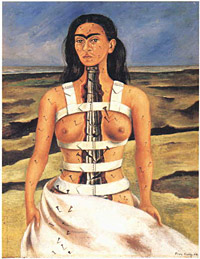Private Letters Give Insight to Frida's Heart
 Wire services Wire services


| | The Broken Column, done in 1944, may be the one of Frida's paintings that show the pain she was feeling the most. The Column itself, which is broken, shows one of the sources of her pain, the nails in her body show in a physical way the pain she was enduring, and the tears in Frida's eyes show that her pain was excruciating. Frida's face shows both courage, and resignation; Frida's nudity may suggest that she felt she could do little about her situation. But in spite of all her pain, Frida kept on expressing herself by making outstanding paintings. |
Twenty-four letters written by Frida Kahlo that went on exhibit in the capital Thursday describe instances of the late painter's physical and emotional pain, as well as her disappointment at never having a child.

The letters, several written to her personal physician, also reveal the fears, obsessions, and, above all, the tireless will to live of one of the greatest figures in contemporary Mexican art.

The exhibition, "Leo Eloesser: Medicine and Pain in the Work of Frida Kahlo," will run until Nov. 19 at the museum that the artist's fans created at her "Casa Azul" in southern Mexico City's colonial Coyoacan neighborhood.

The show is being sponsored by the trust that runs the museums of Kahlo and her husband, artist Diego Rivera, several Mexican cultural groups and the University of California at San Francisco's General Hospital, organizers said.

"The goal of this show is to bring to light an important aspect of the life of one of the bestknown artists in the world. The intensity of Frida's life was not only reflected in her plastic work, but also in her writings," trust director Carlos García told reporters.

Kahlo, who died in 1954 at the age of 47, revealed her feelings in several letters to her U.S. doctor, Leo Eloesser, whom she met in Mexico in 1926 and saw again in San Francisco in 1930, always accompanied by Rivera.

Starting in 1926, the three became close friends and the doctor took on the role of close confidante of the artist not just in health matters but also in other aspects of her private life, even highly personal issues.

"I've been really bored these days in New York, because I haven't seen anybody, I'm not painting or doing anything. I dislike the 'high society' here and feel a little rage against all these fat cats here, since I've seen thousands of people in terrible misery," Kahlo wrote Eloesser in 1931.

The artist's confidence in Eloesser continued to grow over the years, and Kahlo at one point told the doctor that she was jealous of Guadalupe Marín, Rivera's first wife and the mother of his two daughters.

"Please don't get mad at me over what I'm going to say: This morning, when you invited me to the concert, I was determined to go to make you happy and see you, but when I learned that Diego invited the friends of that Marín, who I can't stand, to his box, I lost the desire to go," she wrote.

"I prefer to speak to you frankly, since I know you understand me and will forgive me for changing my mind," Kahlo wrote in an undated note.

Her desire to be a mother, as well as the pain caused by her infertility, was another of the private matters that Kahlo discussed with Eloesser.

"I had so looked forward to having a little Dieguito that I cried a lot, but it's over, there is nothing else that can be done except to bear it," Kahlo wrote after her first miscarriage in 1932.

Personal Mementos

The exhibition also features personal items belonging to Kahlo, including medicines, documents and photographs of Eloesser, as well as some works of art related to her health.

San Francisco General Hospital lent Kahlo's "Portrait of Doctor Eloesser" and Rivera's "La tortillera" to the exhibition. The two works are on display for the first time in Mexico, García said.

Several of the letters were provided to organizers by Juan Pascoe, who owns a publishing house in Tacambaro, in Michoacan state, where the U.S. doctor and his wife, Joyce Campbell, lived.

Pascoe said he never met Eloesser, who died in 1976, but did know Campbell, who gave him the letters on leaving Tacambaro three years ago. |



